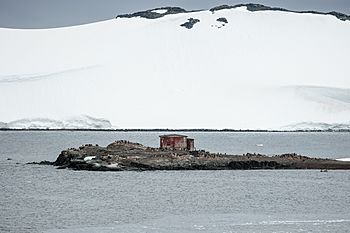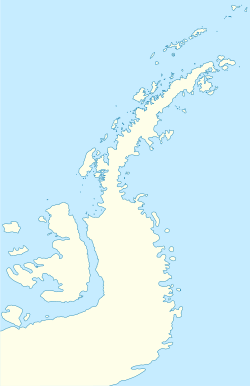D'Hainaut Island facts for kids

Refuge Caillet-Bois on the islet
|
|
|
Location in Antarctic Peninsula
|
|
| Geography | |
|---|---|
| Location | Mikkelsen Harbor, Antarctica |
| Coordinates | 63°54′09″S 60°47′29″W / 63.902421°S 60.791341°W |
| Archipelago | Palmer Archipelago |
| Administration | |
| Administered under the Antarctic Treaty System | |
| Demographics | |
| Population | Uninhabited |
D'Hainaut Island is a small, uninhabited island located in Mikkelsen Harbor, a bay near Trinity Island in Antarctica. It's part of a group of islands called the Palmer Archipelago. Imagine a tiny piece of land in a vast, icy ocean!
Contents
Discovering D'Hainaut Island
This island was first explored and mapped by a French team. They were on an expedition to Antarctica between 1908 and 1910, led by a famous explorer named Jean-Baptiste Charcot.
Later, in 1952, a group from Chile explored the area. They were on the sixth Chilean Antarctic Expedition. This team decided to name the island D'Hainaut Island. They named it after Lieutenant Ladislao D'Hainaut.
The Caillet-Bois Refuge
On D'Hainaut Island, there is a small shelter called Refuge Caillet-Bois. This refuge was built by Argentina to help people exploring Antarctica.
History of the Refuge
The refuge was first opened by the Argentine Navy on December 10, 1954. When it first opened, it had a different name: Port Mikkelsen. This name honored a Danish explorer named Ejnar Mikkelsen.
In December 1977, the refuge was renamed. It was given its current name, Caillet-Bois, to honor an Argentine naval captain and historian named Teodoro Caillet Bois. An icebreaker ship, the ARA General San Martin, helped with this renaming.
Visits and Renovations
After being renamed, the refuge was closed and emptied on January 17, 1978. However, it wasn't forgotten!
In the early 2000s, during the 1999-2000 Antarctic season, an Argentine naval officer visited the shelter. Later, in April 2000, another Argentine ship, the ARA Almirante Irizar, also checked on the refuge.
Most recently, in March 2017, the refuge was updated and fixed up. This work was done by the crew of an Argentine transport ship called the ARA Bahía San Blas.


